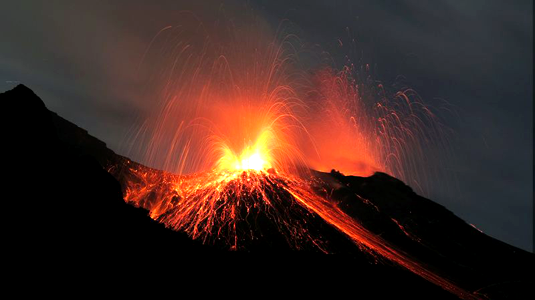
Many volcanoes are located in densely settled areas. Every time one of these becomes active, large populations are put at risk. Hence, one of the primary goals of the current generation of volcanologists is to develop tools that can accurately predict when volcanoes will erupt. In the case of an impending eruption, these tools are of key importance to those charged with making decisions about what action to take and when. “However, the tools available for predicting eruptions are still in their infancy. We can’t always successfully predict an eruption as we lack an understanding of how the warning signs that signal a coming catastrophe are generated, says Donald Dingwell, Director of the Department of Earth and Environmental Sciences at LMU
Under Prof. Dingwell’s supervision, a team of geophysicists has now simulated volcanic eruptions in the laboratory, and asked how well current forecasting models succeed in predicting their properties. “To this end, we have carefully monitored the behavior of samples of synthetic magmas under pressure and recorded the micro-signals that herald their ultimate failure,” says Jeremie Vasseur, a PhD student in Dingwell’s group and first author of the study. “Analyzing these precursory signals and how they evolve is akin to analyzing the seismic signals prior to an eruption.”
Vasseur and his colleagues found that the more heterogeneous the synthetic magma, the more accurately one can predict its failure. Conversely, the forecast becomes progressively less precise as the starting material becomes more homogeneous. The properties of the magma in real volcanoes also vary widely, depending on the extent to which gas-bubbles and crystalline inclusions are trapped in the otherwise homogeneous liquid. “Our results imply that the key to forecasting eruptions lies in knowing just how heterogeneous the magma is,” says Dingwell. “We will continue our efforts to understand the behavior of magmas in the hope that a comprehensive forecasting tool will someday be within our grasp, he adds.
Reference:
Jérémie Vasseur, Fabian B. Wadsworth, Yan Lavallée, Andrew F. Bell, Ian G. Main, Donald B. Dingwell. Heterogeneity: The key to failure forecasting. Scientific Reports, 2015; 5: 13259 DOI: 10.1038/srep13259
Note: The above post is reprinted from materials provided by Ludwig-Maximilians-Universitaet Muenchen (LMU).










